|
|
World's Brightest Bike Lights |
|
|
World's Brightest Bike Lights
2010
Full size images to come pending media release.
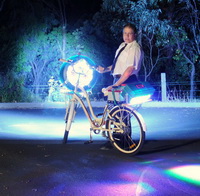 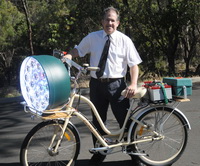  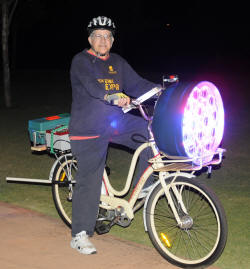
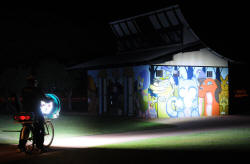
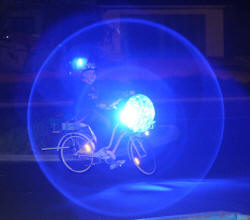 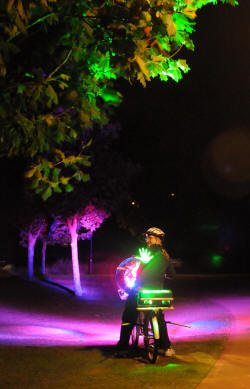
Lighting a lighthouse! Here is ONE 100 W 6000 lumen LED focussed to a 5 degree beam. I will be using 15 of these in the front of the bike. Check out my 100W LED page. The Bunbury lighthouse is on but you cant see it's beams easily in the photo from this angle. The 100W LED runs on three 1.3 AH, 12 V SLA batteries attached to the LED which is resting on on the wooden fence here. It is fan cooled and runs around 3 A 34 V via a 0.4 ohm resistor, if I recall. This is 6000 lumens - remember the 100,000 lumen total figure.
So being a bit more festive, let's light the lighthouse in colours. The last photo is with lights on full with much shorter exposure.
First light for the rear lights (above). These are separate red, blue and green and are mostly decorative at a "mere" 300 W. Shown here with blue (left), red plus blue (center) and red, blue and green (right).
Front lights:
LED data from
Led-world2007
are limited and to my mind insufficient and at variance with other similar
LEDs.
The lumen question marks in the tables below are for the quoted lumens from
similar LEDs from a different manufacturer which might be closer to the
true values.
100 W
Cold white
LED Parameter Min. Max. Unit Luminous Intensity 6000 6500 lm Color Temperature 9000 11000 K Forward Voltage 32.0 36.0 V Forward Current 3200 3800 mA
100 W
Red LED Luminous Intensity 6000 (? 3500) lm Wave Length 625 630 nm Forward Voltage 20.0 24.0 V Forward Current 4000 mA
100 W
Green LED Luminous Intensity 6000
(? 5000) lm Wave Length 520 530 nm Forward Voltage 30.0 36.0 V Forward Current 3200 mA
100 W
Blue LED Luminous Intensity 6000
(? 1200) lm Wave Length 460 470 nm Forward Voltage 30.0 36.0 V Forward Current 3200 mA
Concept
Some of my original concepts are shown above. Things have evolved a bit
since. "Ohh really .... someone else claiming the biggest and best".
Bicycle: Electra, "Townie" ladies bike, cream AU$1300. Chosen by my wife. Ladies bike??? Big advantages of being able to step through and sit on the seat with feet flat on the ground to support the high center of gravity of the battery weight. The front tray is a big plus as well. No point in trying to make a heavily loaded racing bike or mountain bike I reckon. Old lady retro feel styling in cream. (I wanted the purple flowery one but my wife was firm). It has 3 internal hub gears and back pedal brakes. And it has a bell... Our cat and it's WTF expression on first ride of the new bike. Cycle outfit is from my daily ride home on my "normal" bike. Batteries: Three 35 AH Absorbed Power deep cycle batts . These are like car batteries but with better construction to allow greater discharging. From the data sheet, these are good for 12.2 V 35 A dropping to 12.0 V at 12 mins. At 70 A, 11.8 V dropping to 11.7 A at 6 mins. Need 3 batteries to run 34 V at 52 A peak (1.8 kW) delivered to LEDs ie need to drop from (12.0 x 3=36) 36 V to 34 V. 2 V drop at 50 A is barely enough for heavy duty cabling and some big MOSFET's to do pulse width modulation (PWM). This is all a bit on the edge and will call for some tricks. The left photo shows a battery close up, center photo shows shows what happens if you accidentally short circuit them while using a screwdriver to tighten a terminal and the right photo shows one of the three 2.7 A chargers.
Front LEDs
I will use 11 x 100 W
LEDs.
Rated at around 34 V (32 - 36 V) at 3.5 A (3.2 - 3.8 A) with luminous intensity
6000 - 6500 lumens from a 1.8 cm x 1.8 cm surface. Roughly 10 Watt light
output by my calculations and hence have to lose the rest (90 - 110 W) as
heat hence the decent fans. These will be cold white 9000 - 10,000 K colour temp like those annoying expensive blue Xenon car headlights.
The LED ballasting is a complicated issue. The left photo above shows the output of a photodetector taken at switch on of the white LEDs in the final array using a 6 V 18 W filament as ballast. Note the 5% increased light output at switch on which tails off in the first 100 ms or so as the light globe ballasts heat up. I had thought it might be greater. The right photo shows the current at switch on is almost 100% greater at 7 A reducing over the next 200 ms as the filament heats up. It suggests that I am running the LEDs (at least a single LED with a full battery charge), close to its maximum. Here are the current and voltages at switch on of all 18 LED's on the bike. Peak is 68.6 A (3.8 A per LED) which settles to 52.9 A (3 A per LED) 2.0 seconds later. Peak power is 2682 W settling to 2004 W. The red LED uses both filaments of the 6V 18 W+18 W to drop 12 V, plus a 1.5 ohm 15 W resistor to drop a further 4 V, whereas the blue and green use one of the filaments only. I have a later option to switch in the second filament if the main voltage sags too much under load. Here are some sources for 100 W LEDs and specs. Snowdragon. The left photo above shows me starting the front array construction, center photo shows how the fans will sit and the right photo shows first light of a single 100 W LED. Note the weak 150 + 150 W shed lights. The left photo above shows the front array construction with red, green, blue and white LED's at low power. Center photo shows the rear view with the rats-nest of wiring becoming evident, and the right photo shows first light of the partial front array on the bike. "Only" drawing 700 W at this stage out of target 2000 W.
Controls So far only RGB switching basic capability at present.
Rear LEDs The red green and blue lights above left give really colourful shadows. The basic LED mounted onto the heatsink is shown center and the effect of the lens shows the fine detail of the 1W 10 x 10 array of LEDs on the right. Above shows the mounted LED's in the rear array which can be tilted vertically (for the Xmas tree project). The plastic toolbox is an excellent fit for the red, green and blue rear lights fans and optics. It is compact and I will be able to swivel it as well. Above shows the as yet unwired rear array. The center photo shows current of 9.3 A 37 V = 344 W. Love this clamp meter with 40 A DC scale - bought it especially for this project. Ballasting of the Blue and Green LEDs is via 6V 18 W globes. The Red LED runs a lower voltage so has 6 V 18 + 18 W plus a 1.5 ohm, 15 W resistor in series. Above shows the low power (2 W) tail light riding mode with a normal tail light for comparison. Keeps it street legal (maybe). You can see each of the 1 W LEDs in the array.
Electronics Every man needs his shed...
Heatsinks and Fans
Lenses I made an outrigger stand in the left photo, as the inbuilt one would not handle the 33 kg battery weight so high up. I cut up a tri-bar set that I got for a few dollars from a tip years ago. These are extensions to the handlebar of a road or mountain bike out forward for a better racing position for triathletes in particular. Add a PVC conduit and these can provide a good support and can be flipped backwards out of the way when the bike is being ridden. For trailer use a more solid setup was needed in the right photo. Reminds me of the pun: A bicycle can't stand on its own because it is "two tired".
Then I made a battery tray out of perforated angle iron
and particle board. Simple and effective but
quick. Downside is the centre of gravity is high but it is much more compact
and unobtrusive than some other ideas I had.
It handles like a tank but is still rideable. But
don't I look stylish riding it! Don't forget that this is a show bike and
not really for much road use.
Also able to do the heavy cabling to the front of the
bike - needed as can't afford much voltage drop at all at 55 A+. Black cable
had 85 mV and red cable 235 mV including switch ie a total of 0.3 V at full
load. Meters above, read 55 A, 33 V and water coolant 65 degrees C during a power test. It took me a bit by surprise that the bucket of water reached almost 80 degrees C and I had to dash out to get more cooling water. That's what 1800 W does.
Media
World's Brightest Flashlight
2010
The
front array of high powered LEDs of 90,000 lumens attached to a battery
pack in a (sort of) flashlight body gives the "muscle" flashlight
here.
The three photos above are from my first distance shot. 2.5km along the
straight stretch of Lillydale Rd out of Bunbury.
Chris Russell (4HV admin) stated "And, just for fun, if TDU were to stand on
a mountaintop and shine his flashlight at an observer far below, 10km away,
on a clear night: 0.0701 lux, -11.1 apparent visual magnitude. That's
brighter than a half-full moon, and given the beam profile, probably bright
enough to start triggering alien abduction stories."
SpecificationsSpecifications
Concept It's easy to make a claim of being the "World's best" at anything and rather hard to refute particularly if there is no independent arbiter such as Guinness World Records, particularly if it has not appeared on the net. Of course, sometimes it's comparing apples and oranges. Like mine is not commercially useful, theirs is. Mine can't be focussed well, theirs can. Hence theirs will have higher peak intensity at a distance (candlepower) due to better focus. But mine has more total light output (lumens). I have now applied to the Guinness World Records as world's most powerful flashlight. However on further perusal, there is no online reference to any flashlight as being brightest or most powerful. Why might this be? I speculate that the "brightest" handheld light is going to be a laser with unrivalled intensity at 1 mile in a small spot. The beam divergence is so low that it will be hugely bright at a distance if looked at or measured. So brightness at a distance is not really a good measure of what a flashlight is all about. What about total light output measured in lumens? This is the best measure of light power output and is in common use, however, it is very hard to measure with a non uniform beam. Sure it is easier with a source projecting evenly throughout 180 degrees but few light sources are like this. My 100,000 lm is the summation of LEDs derived from manufacturers information when the LEDs are driven to specification. So what to do?
Construction Take one domestic kitchen bin with defunct automatic lid opener removed plus the top of a domestic rainwater tank. Presto!
Bike Xmas tree
2010
| ||||||||||||||||||||||||||||||||||||||||||||||||||||||||||||||||||||||||||||||||||||||||||||||||||||
This page was last updated March 02, 2011